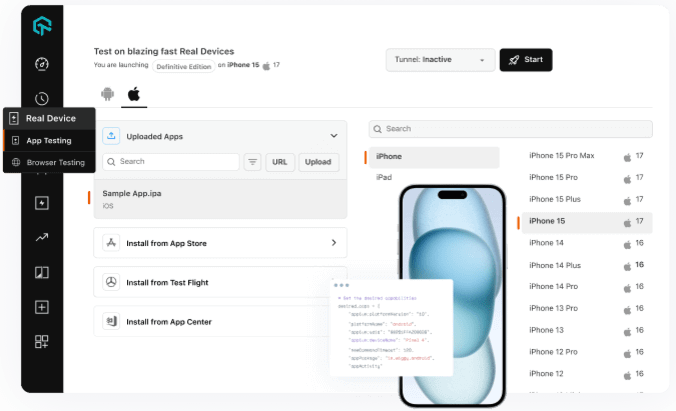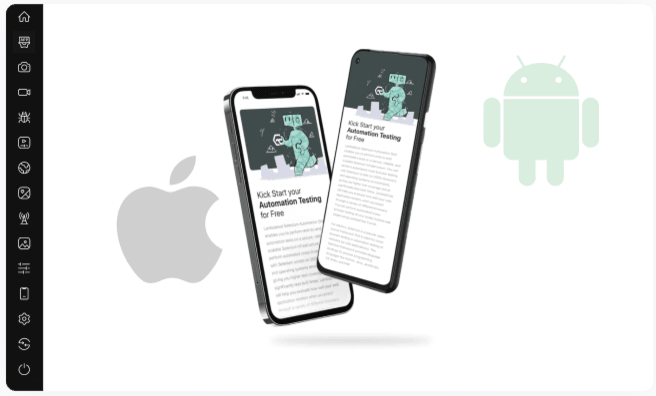App testing refers to evaluating software applications to ensure functionality, usability, and reliability before release to ensure a smooth user experience.
To test Android apps, you need to follow a few key steps. First, ensure the app installs correctly on various Android devices. Then, thoroughly test its features and functionality to ensure they work as intended. Evaluate the user experience (UX) and user interface (UI) design for usability. Verify compatibility across different devices and operating system versions. Assess app performance, including speed and responsiveness and conduct security testing to identify vulnerabilities and protect user data. Finally, perform regression testing by re-testing previously working features after any changes or updates. Remember to combine manual and automated testing for comprehensive app testing.
Mobile app testing is crucial to ensure that apps function as intended across various devices and operating systems. It helps identify and rectify bugs, glitches, and compatibility issues, ensuring a seamless user experience, optimal performance, and the overall success of the app in the competitive mobile landscape.
There are several types of mobile testing crucial for ensuring the functionality and performance of mobile applications. These include Functional Testing, which checks if the app functions as intended, Usability Testing, focusing on user experience and interface navigation, Performance Testing, ensuring the app runs smoothly under various conditions, Compatibility Testing, verifying compatibility across different devices and operating systems, Security Testing, examining vulnerabilities and data protection measures, and Regression Testing, ensuring that new updates or fixes don't break existing features. Each type plays a vital role in delivering a seamless and reliable mobile app experience to users.
To conduct thorough testing of iOS apps, follow these essential steps. Begin by verifying seamless installation on a variety of iOS devices. Then, meticulously test all features and functionalities to ensure flawless performance. Pay close attention to user experience (UX) and user interface (UI) design, striving for intuitive and visually appealing interactions. Validate compatibility across diverse iOS versions and screen sizes. Assess app performance, responsiveness, and loading times for optimal user satisfaction. Execute comprehensive security testing to identify and address any vulnerabilities, prioritizing the protection of user data. Finally, perform rigorous regression testing to guarantee the stability of previously functioning features after updates or modifications. By combining both manual and automated testing approaches, you can achieve comprehensive and robust testing of iOS apps.
To run automated mobile app tests on emulators and simulators, you can follow these steps. First, set up your testing environment by selecting the appropriate emulators and simulators for your target devices and operating systems. Install the necessary software development kits (SDKs) and tools to enable testing on emulated environments. Next, choose a reliable test automation framework such as Appium or Espresso that supports emulator and simulator testing. Develop test scripts using the chosen framework to simulate user interactions and validate app functionalities. Execute the test suites on the emulators and simulators using the automation framework, leveraging features like parallel test execution for efficient testing. Analyze the test results to identify any issues or failures and make necessary improvements. By following this approach, you can effectively run automated mobile app tests on emulators and simulators, ensuring the quality and performance of your app before deploying it on real devices.
Testing web apps on devices is a crucial process to ensure optimal performance and compatibility. It involves several key steps. Firstly, you need to identify the target devices and operating systems on which your app will be tested. Then, set up the testing environment either by installing the required browsers on the devices or utilizing a reliable cloud-based testing platform like LambdaTest. Thorough functional testing should be performed to verify that all features and functionalities work as intended. Additionally, it is important to test the responsiveness of your app across different devices, screen sizes, and orientations to ensure a seamless user experience. Validate cross-browser compatibility by testing your app on various browsers and versions. Assess the performance of your web app, including page load times and responsiveness, on different devices. Finally, conduct usability testing to evaluate the overall user experience and identify any usability issues. By following these steps diligently, you can ensure that your web app performs flawlessly and delivers an exceptional user experience across a wide range of devices.
To run automated mobile app tests on real devices, follow these steps. First, select the real devices you want to test your mobile app on, considering various factors such as device models, operating systems, and screen sizes. Next, set up a robust test automation framework like Appium or Espresso that supports real device testing. Connect the selected devices to your testing environment or use a cloud-based testing platform like LambdaTest that provides access to a wide range of real devices. Develop test scripts using the chosen automation framework, ensuring they cover all critical app functionalities. Execute the test suites on the real devices either through a local testing setup or by leveraging the capabilities of a cloud-based platform. Analyze the test results and reports to identify any issues or bugs. By following this approach, you can conduct comprehensive and reliable automated mobile app tests on real devices, ensuring your app's performance and functionality meet the highest standards.







Mimic real-world scenarios
Install multiple apps in a single session
Test native, hybrid, and web apps


Support for Appium, Espresso and XCUITest
Opt for parallel testing to reduce execution time
Test OTT applications on real smart TV devices










21 - 23 Aug















